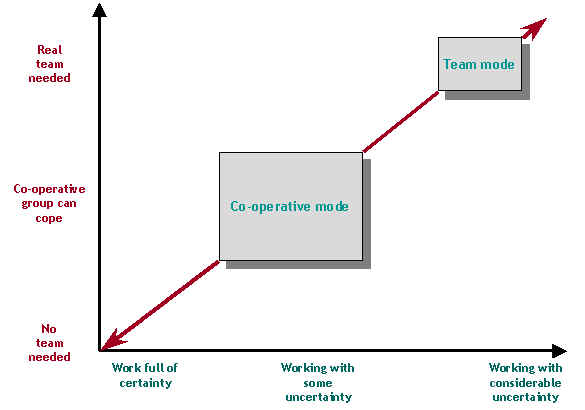We prefer to use the term team development to the more familiar team building. The notion of 'building' can become a bit mechanical; something which is 'done to' the team from outside. Our perspective is that teams develop by being offered opportunities to share and work together.
Our approach
We use Katzenbach & Smith's hierarchy of teams to offer a model of different kinds of team working:
High Performance Team: A
real team whose members are also deeply committed to one another’s personal growth
and success.
|
|
Real Team: A number of people with
complementary skills who are committed to a common purpose, goals & approach, for
which they hold themselves accountable.
|
^ |
Potential Team: A team which
recognises and is trying to achieve improved performance, but lacks clarity about purpose,
goals & a common working approach.
|
^ |
Working
Group: The members interact to
share information, practices or perspectives in order to help each individual perform
within his or her own area. No common goal or shared responsibility.
|
^ |
Not every team needs to be a high performance team. Traditionally senior management teams have been collaborative working groups rather than teams. A model from David Casey & Bill Critchley is helpful here:

They argue that they greater the uncertainty in the task and environment the greater the need for people to work together in high performance teams. We offer organisations the opportunity to consider their own needs rather than trying to impose models which may not be appropriate.
Another helpful, but little known, model comes from Marcial Losada. He observed a number of team working on strategic issues. He coded the interactions between team members and also graded the teams into high, medium and low performance teams (based on company performance, peer review and customer feedback). He was particularly interested in the amount of connectivity between team members, the ratio of inquiry and advocacy, the ratio of statements about self and statements about others, and the amount of positive versus negative statements. The results of his investigations are summarised below:
|
Connectivity |
Inquiry/advocacy |
Self/other |
Positive/negative |
High Performance |
High |
Balanced |
Balanced |
High |
Medium performance |
Medium |
Towards advocacy |
Towards self |
Balanced |
Low performance |
Low |
Advocacy dominant |
Self dominant |
Negative dominant |
We use models such as these to help diagnose the team's needs and also offer direct feedback which can help team members understand their behaviour and start to modify it appropriately. We work with teams to develop a range of simple and challenging activities which enable them to learn how to work better together and how to develop a supportive and enabling culture.
References
Casey, David 1993. Managing Learning in Organisations. Buckingham: OUP.
Katzenbach, Jon R. & Smith, Douglas 1998. The Wisdom of Teams. McGraw-Hill.
Losada, Marcial 1999. “The Complex Dynamics of High Performance Teams” Mathematical and Computer Modelling (Elsevier Science, Oxford, UK)





